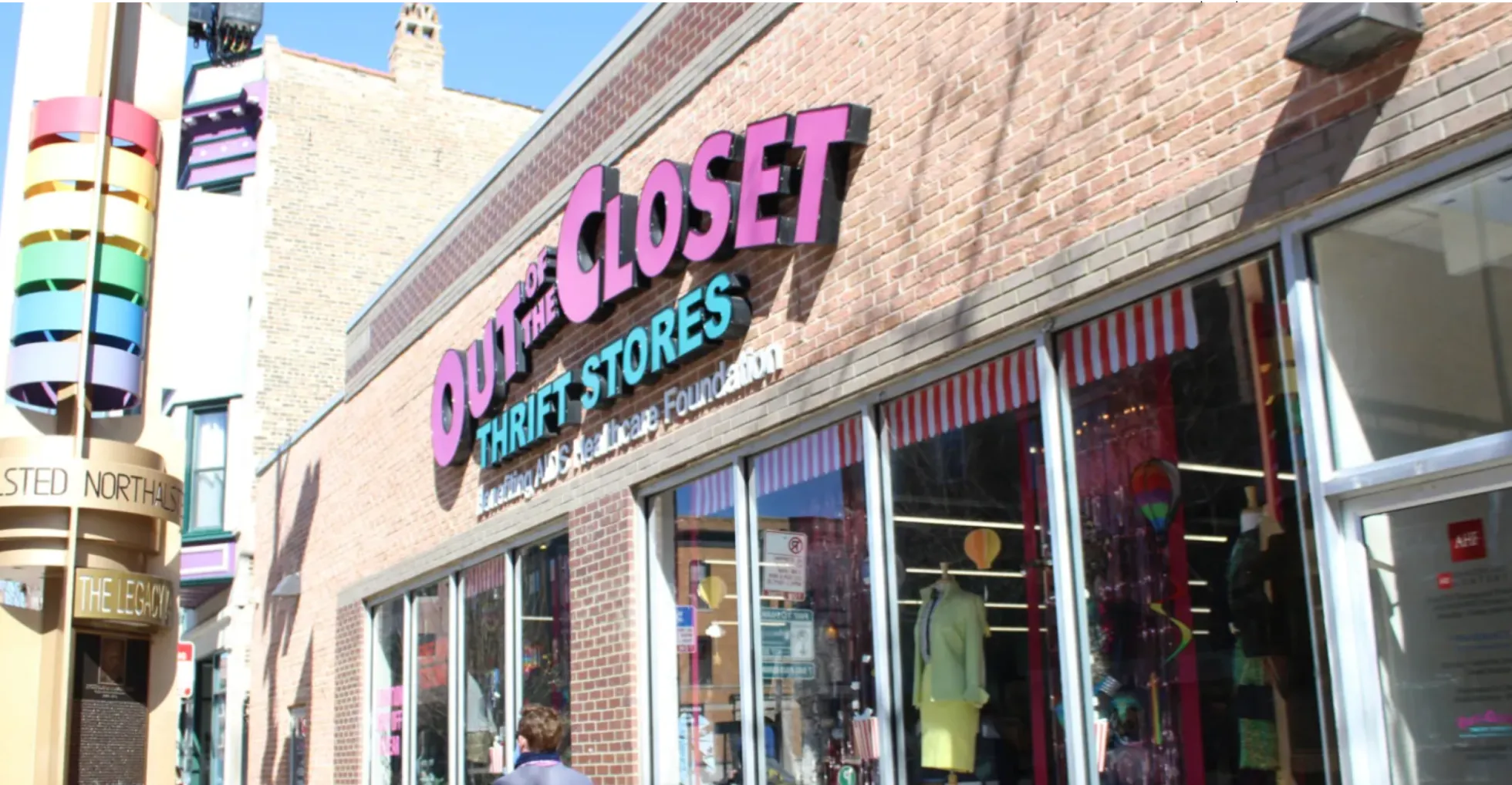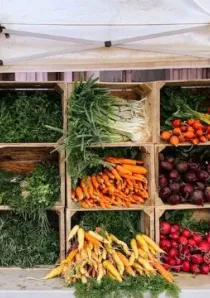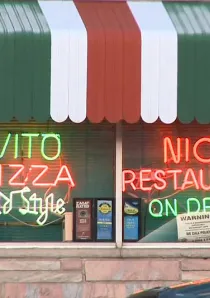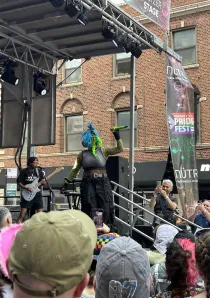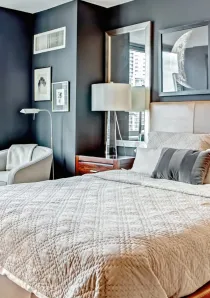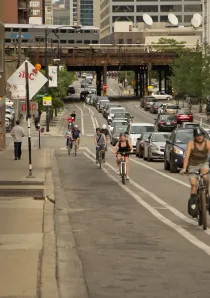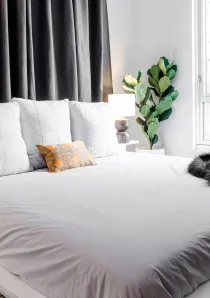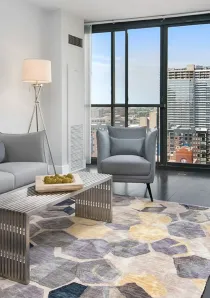Chicago thrifters know a secret: our city hides some of the best secondhand treasures in the country. Between the racks of neighborhood thrift stores, you might find yourself brushing past vintage Levi's jackets, coveted designer bags, or that perfect statement piece to make your apartment neighbors jealous.
What makes Chicago's thrift scene special is how each neighborhood puts its own stamp on the experience. The vibe in an Andersonville vintage boutique feels worlds apart from the treasure hunting in Rogers Park. Prices, selection, and style vary wildly depending on which L stop you hop off at.
How a Vera Wang Wedding Gown Ended Up at Goodwill (and What That Means for Chicago Thrifters)
Somewhere between the racks of secondhand jeans and stacks of half-used scented candles, a shopper at a suburban Chicago Goodwill stumbled across something unexpected: a Vera Wang wedding gown. Not a knockoff. Not a well-loved dupe. The real thing—worth thousands when new, now sitting quietly among the polyester bridesmaid dresses, waiting for someone with a good eye.
Stories like this are the kind of thrift shop legends that keep secondhand hunters coming back. One minute, you're sorting through a pile of Old Navy cardigans, and the next, you're holding a designer piece that someone, for reasons unknown, decided to donate. Maybe it was an impulse buy. Maybe it carried memories best left behind. Either way, it’s proof that thrift stores aren’t just a last stop before the landfill—they’re a revolving door of hidden treasures waiting for the right person to walk in.
So grab your reusable shopping bags and comfortable shoes because we're about to take you on a neighborhood-by-neighborhood tour of Chicago's best thrift spots. From high-end consignment to by-the-pound bargain bins, here's where Chicago really shops secondhand.
North Side Thrift Scene: From Boutique Vintage to Budget Bargains
Andersonville: A Vintage Shopping Haven
If you prefer shops where someone has already filtered out the duds, Andersonville should rank high on your thrifting itinerary. This historically Swedish part of town features some of Chicago's most carefully curated secondhand shops, with quality over quantity being the guiding principle.
You've probably spotted Buffalo Exchange (5252 N Clark St) around the city (they're not exactly a mom-and-pop operation), but their Andersonville location hits different. The staff knows fashion history and won't give you the side-eye when you ask if those acid-wash jeans are "back" or just tragically uncool. It's chain shopping without the chain attitude.
The same goes for 2nd STREET (5228 N Clark St), another multi-location spot that brings a slice of Tokyo streetwear culture to Chicago. Here's where the sneakerheads and hypebeasts score pre-loved Supreme and BAPE without the heart-stopping retail prices. Just don't come expecting bargain basement deals – quality costs, even secondhand.
The Brown Elephant's Andersonville location (5404 N Clark St) could be considered a neighborhood anchor. Not only does your shopping support LGBTQ+ healthcare through Howard Brown Health Center, but their sprawling space offers more room to hunt than most boutique spots. From barely-worn contemporary apparel to genuine vintage finds, their clothing section rewards those who make regular visits.
Then there’s the local indie favorite, Demolition Collective (5706 N Clark St). This sweet shop offers California-sourced vintage apparel that stands out from typical Midwest finds. They're known for their streetwear that draws fashion-forward shoppers from across the city.
Lakeview & Lincoln Park: Upscale Resale Central
When Lakeview and Lincoln Park residents clean out their closets, the rest of us win. These upscale districts feed some of Chicago's best designer resale shops, where yesterday's impulse purchases become today's steals.
McShane's Exchange (2012 N Halsted St) is practically a fashion archive disguised as a consignment shop. The racks are packed with last season's designer digs that still have red-carpet potential. Elliott Consignment has two locations (3015 N Broadway & 2465 N Lincoln Ave) and takes a similar approach but with a slightly more accessible price range – think attainable luxury rather than "Do I really need to eat this month?"
Cynthia's consignment (2218 N Clybourn Ave) feels like shopping with that aunt who always looks perfectly put-together. The staff won't let you walk out with something that doesn't flatter you, which is either amazing service or slightly terrifying, depending on your shopping personality.
For the more theatrically inclined, Beatnix (3400 N Halsted St) serves vintage with a side of drama. Their racks are stuffed with decades of statement pieces that scream, "I have interesting hobbies and excellent taste." Meanwhile, Shangri-La Vintage (1952 W Roscoe St) is for purists who can spot the difference between actual 1960s mod and modern knockoffs from twenty paces. Their collection spans multiple decades but maintains a standard that would make vintage collectors weep with joy.
Out of the Closet (3311 N Halsted St) blends thrift with purpose. Proceeds support HIV/AIDS care, but it’s the bold, unpredictable mix on the racks that keeps locals coming back. You’ll have your pick of retro tees, denim with attitude, and the occasional sequin body suit.
Crossroads Trading (2711 N Clark St) is a staple for Lakeview locals who want name-brand jeans without paying name-brand prices. The selection leans young and trendy—Zara, Madewell, and the occasional pair of barely-worn Doc Martens. This is the spot where last season’s wardrobe cleanouts from DePaul students and young professionals end up.
Edgewater & Rogers Park: Student-Friendly Bargains
Up north, where Loyola students roam and budgets get tighter, thrifting returns to its beautiful, chaotic roots. Edgewater and Rogers Park are where the hunt gets real, folks.
New To You Thrift Shop (1545 W Morse Ave) embodies old-school thrifting energy – slightly disorganized, refreshingly affordable, and ripe with potential for those willing to dig. One day, you'll find nothing; the next, you'll score designer jeans for less than your morning latte. It's thrifting roulette at its finest.
Sophie's Closet (6124 N Broadway) caters to the college crowd with prices that won't compete with textbook costs. The inventory moves fast as students cycle through trends and seasons, making it a spot that rewards frequent visitors.
Crème de la Crème (1352 W Devon Ave) splits the difference between Rogers Park affordability and Andersonville curation. It's where you go when you need something presentable for a job interview but your bank account is sending you distress signals.
Pro tip: Hit these North Side spots mid-week when the weekend warriors are at work. You'll have more breathing room between racks and first dibs on fresh merchandise before the Saturday crowds descend.
West Side Thrift Scene: Hip Havens for Vintage Hunters
Wicker Park: Where Thrifting Meets Trendspotting
Wicker Park has evolved from artistic enclave to hipster headquarters, and its thrift scene reflects this journey perfectly. This is where Chicago's fashion risk-takers come to play, with secondhand shops that feel more like style incubators than mere clothing stores.
Vintage Underground (1507 N Milwaukee Ave) might be underground (literally – it's in a basement), but there's nothing hidden about its bold approach to vintage. Their racks burst with statement pieces spanning the 1940s through Y2K, meticulously organized by decade and color. The prices reflect the curatorial effort, but you're paying for clothing that won't show up on anyone else at the party.
For a completely different vibe, Kokorokoko (1323 N Milwaukee Ave) celebrates everything gloriously tacky about the 1980s and 90s, with neon windbreakers, geometric print shirts that would make Saved by the Bell proud, and enough denim to clothe a small nation. The owners' enthusiasm for these decades is infectious, so good luck leaving without something that would make your childhood self incredibly jealous.
Una Mae's (1528 N Milwaukee Ave # 1) strikes the perfect balance between vintage finds and emerging independent designers. Their thoughtfully arranged space feels like the closet of that effortlessly cool friend who always looks put-together without trying. The shop has evolved beyond its vintage roots to include new items, but their secondhand section remains a goldmine for quality basics with unexpected details.
Crossroads Trading (1519 N Milwaukee Ave), a well-established secondhand chain, has found a particularly stylish niche in Wicker Park. The location benefits from local residents with enviable wardrobes and seasonal cleaning habits. Their racks showcase high-quality, contemporary styles that seamlessly complement the area's fashion-forward reputation.
Throughout Wicker Park, expect to pay more than you would in less trendy neighborhoods. The trade-off is a level of style curation that saves you hours of digging through duds. Most shops feel like they've been arranged for an Instagram photoshoot – because let's be honest, they probably have been.
Logan Square: Thrifting with Creative Edge
Just a bit northwest, Logan Square offers a thrift scene that feels more exploratory and less curated than its Wicker Park neighbor. The vibe here is decidedly more communal, with shops that celebrate individuality without the sometimes intimidating coolness factor.
Low prices and a nonprofit mission set Monarch Thrift Shop (2875 N Milwaukee Ave) apart from the usual secondhand experience. Proceeds support mental health awareness, giving each purchase a little extra meaning. The inventory strikes a balance between practicality and hidden surprises, where everyday basics hang alongside vintage finds, all at prices that remind you why thrifting became popular in the first place.
Digging through the racks at El Dorado Thrift (2634 N Milwaukee Ave) feels like classic thrifting done right—unpolished but intentional. There’s no over-merchandised display to sift through, just a steady rotation of well-priced secondhand clothing. The Spanish-speaking staff makes the shop especially welcoming to the neighborhood’s diverse mix of shoppers, and unlike much of Logan Square, the prices haven’t caught up with the area’s rising rent.
Shoppers looking for soft, feminine silhouettes from past decades will find their match at Vintage Frills (2846 N Milwaukee Ave). The collection leans into floral prints, flowing skirts, and costume jewelry that wouldn’t look out of place in a mid-century fashion spread. With a strong focus on the ‘50s through ‘70s, the pieces here feel more like preserved snapshots of style history than just another batch of secondhand clothes.
A new addition to Logan Square, Stylish Sin (2773 N Milwaukee Ave) dials up the drama with an alternative edge. The shop specializes in goth-friendly fashion, clubwear, and bold vintage that leans more toward nightlife than nostalgia. Black-painted walls and striking displays make it clear: this is a store for those who like their vintage with a rebellious streak.
Lost Girls Vintage (1935 W Division St) has put down roots with a brick-and-mortar shop that channels the same adventurous spirit as their original truck. Inside, you'll find a well-curated mix of secondhand items—denim, leather, retro prints—that still moves fast, so regulars know to swing by often. Good vintage, after all, doesn’t stick around.
A word to the wise: The West Side thrift scene moves at lightning speed. New merchandise arrives multiple times weekly, and the best items rarely survive a weekend. Savvy shoppers know to schedule their hunts for mid-week when fresh inventory hits the racks and the weekend crowds haven't picked everything clean.
South Side Thrift Scene: Cultural Fusions and Academic Gems
Pilsen: Vibrant Heritage Through Vintage Lens
Step into Pilsen's vintage corridor, and you'll be immediately immersed in a completely different secondhand universe. The neighborhood's Mexican-American roots and artistic spirit create a thrifting experience rich with cultural significance and creative energy.
For decades, Knee Deep Vintage (1219 W 18th St) has anchored the area's secondhand scene, housing an eclectic assortment that spans eras. Their specialty lies in garments with distinctive character – hand-embroidered Mexican blouses displayed alongside classic American workwear, creating a visual dialogue between cultures. The shop feels like a living museum where everything happens to be for sale.
Bold visual storytelling defines the approach at Pilsen Vintage (1430 W 18th St) with their saturated color groupings and theatrical displays celebrating the neighborhood's artistic heritage. The selection leans toward statement pieces with cultural significance rather than passing trends.
Traditional Mexican textiles mingle with modern secondhand styles at Segunda Alicia (1456 W 18th St), creating something you won't find in any chain store. This family-operated boutique feels like stepping into a cultural crossroads where vintage huipiles hang beside reworked contemporary fashion. What makes this spot special is how it functions as both a preservation project and fashion source—keeping textile traditions alive while ensuring these beautiful crafts don't just end up in museums but on the backs of stylish Chicagoans who appreciate their history.
Very Best Vintage (1346 W 18th St) lives up to its confident name through ruthless selectivity - they'd rather have ten perfect leather jackets than fifty mediocre ones. Their denim wall has achieved cult status among Chicago's jean enthusiasts who appreciate that real-life wear patterns tell better stories than factory-made distressing ever could. Just down the street, C&J Collections (1932 S Halsted St, Suite 502) takes vintage to another level entirely. These aren't just sellers but transformers who might add hand-embroidered flowers to a bland blazer or rework a dated dress into something that could stride down a runway.
Then there’s 18th Street Vintage (1549 W 18th St), keeping things refreshingly democratic with prices that longtime Pilsen residents can still afford, pushing back against the tide of boutique-ification that's turned secondhand shopping into a luxury experience elsewhere in the city.
Bridgeport: A Blend of Tradition and Trend
Bridgeport technically falls on the South Side, but its secondhand scene doesn’t mirror Pilsen’s vintage-meets-art aesthetic. Instead, it leans into practicality. The shopping experience here feels more relaxed—less about curated perfection and more about straightforward, no-fuss thrifting.
Unique Thrift Store (3000 S Halsted St) takes a more traditional approach than boutique-style spots elsewhere. The space is large, the selection unpredictable, and the prices stay reasonable, making it an easy place to spend an afternoon hunting for a mix of basics and the occasional designer resale. Consume Vintage (3452 S Western Ave), a smaller shop that shares space with a café, leans into casual cool, stocking well-worn band tees, rugged denim, and vintage workwear that carries real history in its stitching.
The R.O.C.K. Exchange Resale Boutique (3551 S Archer Ave), on the other hand, brings a more polished approach. Everything is hand-checked for quality, arranged by aesthetic rather than standard sizing, and geared toward shoppers looking for reliable secondhand pieces without the usual digging.
Bridgeport’s secondhand scene isn’t built for hype, and that’s what makes it refreshing. There’s no pressure to know the latest trends or prove your vintage expertise—just well-priced finds in a low-key environment where shopping actually feels enjoyable.
Chain Thrift Stores vs. Unique Boutiques
Chicago's secondhand scene includes dramatically different store types across the city. Understanding these business models saves time, money, and helps you know exactly where to hunt for what you need.
Cash or Credit? The Buy-Sell-Trade Model
Those polished storefronts with carefully arranged window displays operate on a buy-sell-trade model, purchasing clothing directly from sellers rather than accepting donations. This creates higher quality control but also higher price tags.
Buffalo Exchange remains the city's most recognized player in this category. They'll offer you 25% in cash or 50% in store credit for items they accept - which tends to be about one in four pieces people bring in. Their buyers are notoriously selective, following current trends and seasonal needs. What this means for shoppers: expect to pay $15-50 for most clothing, with designer labels commanding significantly more.
The Japanese-influenced 2nd STREET operates similarly but leans heavily into streetwear and premium brands. Their pricing reflects this specialty. Supreme tees and rare BAPE hoodies can run three figures, but their vintage denim selection offers better value for quality-conscious shoppers.
Crossroads Trading completes the buy-sell-trade trifecta with its multiple Chicago locations. Their 30% cash/ 50% credit split mirrors Buffalo Exchange, but their selection often feels slightly less trend-obsessed and more wearable for everyday Chicagoans. Still, prepare to spend $15-60 for standard finds and over $100 for designer pieces.
Independent Vintage Boutiques
While chains follow rigid systems, Chicago's indie vintage stores operate with flexible business models that change from shop to shop. Most blend direct buying, consignment arrangements, and careful sourcing from estate sales and private collectors.
Selling to these boutiques requires more strategy than dropping items at Buffalo Exchange. The standardized 30/50 split doesn't exist here – instead, store owners negotiate individually for pieces they want. Some pay 40-60% of the anticipated selling price for exceptional items purchased outright, while others prefer consignment deals where you might receive 50-70% after the item sells. The advantage is that small shop owners often accept distinctive or avant-garde pieces that trend-focused chains would pass on.
For shoppers, prices at independent boutiques typically start higher ($25-200+) than at thrift chains, reflecting specialized curation and historical knowledge. Your purchase includes not just clothing but expertise, with proprietors who can often identify the exact decade, designer influence, and construction details of their merchandise.
Many boutiques cultivate dedicated followings through personalized attention absent from larger operations. Frequent customers might get text alerts when items matching their style arrive, early access to new threads, or even custom sourcing for specific requests.
Unlike Goodwill, you can't just dump bags of unwanted clothes at these boutique doors. Most indie shops won't even look at your stuff without an appointment, and they'll probably ghost you if you show up with a garbage bag full of H&M. Save yourself the awkward rejection and call ahead. Each shop hunts for different decades and styles, and they're brutally picky about condition. That Forever 21 top from three seasons ago? Don't even bother. But that weird sequined jacket your grandma left you might be exactly what they're looking for.
Donation-Based Bargains: Nonprofit Thrift Stores
When you're truly bargain hunting, nonprofit thrift stores deliver the goods. These shops run entirely on donations, meaning their inventory can be wildly unpredictable, but half the fun is in the hunt.
The Brown Elephant combines reasonable prices ($5-30 for most clothing) with social impact; your vintage t-shirt purchase might help fund someone's healthcare. Their three Chicago locations offer better organization than most charity shops while maintaining accessible pricing.
Goodwill locations throughout Chicago represent thrifting in its traditional form. Prices start remarkably low ($3-10 for most clothing), making wardrobe refreshes possible on nearly any budget. While staff have gotten better at spotting premium brands, plenty of higher-end items still slip through unnoticed.
Salvation Army stores operate on a similar donation-based model with rock-bottom pricing. The real advantage here comes through their color-coded weekly sales that slash already low prices by 50% on rotating tag colors. Timing these sales right can result in absurdly good deals.
Volume Players: Hybrid Discount Chains
Falling somewhere between nonprofit thrifts and curated boutiques, stores like Unique Thrift (part of the Savers family) offer massive inventory with slightly more organization than your average charity shop.
These hybrid operations supplement donations with overstock purchases from major retailers, creating a more predictable shopping experience. Pricing lands in the middle range - $5-15 for clothing, $20-50 for furniture - but their real advantage is sheer volume. With thousands of items hitting the floor weekly, your chances of finding something special increase dramatically with regular visits.
Strategic Thrifting: Knowing When to Go Where
Each type of secondhand shop serves a specific thrifting mission:
Broke but still want to look good? The nonprofit circuit has your back. The Brown Elephant, Goodwill, and Salvation Army keep prices rock-bottom and run regular discount days that make cheap finds even cheaper.
Hate digging through endless racks? Buy-sell-trade spots like Buffalo Exchange, 2nd STREET, and Crossroads do the filtering for you. The higher prices buy you time and sanity – everything on the floor has already passed someone's quality check.
Need something nobody else will be wearing? Independent vintage boutiques specialize in standout pieces with actual history. Yeah, you'll pay more, but that one-of-a-kind 1970s leather jacket with the hand-painted back can't be found at the mall at any price.
Love the thrill of the hunt? Volume-based shops like Unique Thrift Store are your paradise. Their constant turnover means Monday's racks bear no resemblance to Sunday's – dedicated diggers who visit regularly score the serious deals others miss.
Chain Thrift Stores: A Neighborhood-by-Neighborhood Breakdown
Same store name on the sign, completely different treasures inside. Here's what Chicago thrifters know about the city's chain locations that tourists and casual shoppers miss:
Buffalo Exchange
Wicker Park (1478 N Milwaukee Ave): The hypebeast headquarters. This location gets first dibs on streetwear drops, vintage denim jackets, and anything that might get 100+ likes on Instagram. Staff here can spot fake Supreme from across the room, and they price the real stuff accordingly. Weekends are a zoo, but Tuesday restocks make weekday visits worth calling in "sick" to work.
Andersonville (5252 N Clark St): The more mature, sophisticated sister to the Wicker Park location. The racks here skew toward quality basics, professional wear, and understated luxury rather than flashy statement pieces. The clientele tends to be older and more established, resulting in higher-quality wardrobe staples.
Lakeview (2865 N Broadway): The wild card of Chicago's Buffalo Exchange locations. Thanks to proximity to both Boystown and DePaul University, this store combines young, experimental styles with theatrical flair. It's the go-to for costume components, bold accessories, and the occasional high-end designer piece from nearby Lincoln Park closet clean-outs.
Crossroads Trading
Lincoln Park (2711 N Clark St): Denim paradise, pure and simple. The premium jeans section alone justifies the trip—rack after rack of barely-worn AG, Frame, and Citizens of Humanity that somehow didn't work for Lincoln Park's exacting shoppers. The price tags might give you pause ($40-70 range) until you remember these same jeans run $200+ new.
Wicker Park (1519 N Milwaukee Ave): The "cool older sibling" of Chicago Crossroads locations. The buyers here clearly prioritize unique pieces over conventional brands, making it the spot for standout jackets, reimagined vintage, and small designer labels you won't find at the mall. The prices reflect this selectivity, but so does the compliment count when you wear your finds.
Logan Square (2711 N Milwaukee Ave): The newest kid on the Crossroads block still feels more accessible than its cousins. The merchandise mix bridges practical and trendy without veering into either extreme. Their men's section is particularly impressive, with sizing beyond the typical small/medium options that dominate most thrift racks. Sunday afternoons bring fresh inventory from weekend sellers.
Village Discount Outlet
Roscoe Village (2043 W Roscoe St): The graphic tee goldmine and cutoff capital. While other thrift chains have gotten wise to vintage band shirts, this VDO location still prices them like regular tees. The secret? Longtime residents cleaning out closets full of authentic '80s and '90s clothes that never went through the reseller circuit.
Jefferson Park (6418 N Central Ave): Where grandparents' closets go to find new life. This Northwest Side location specializes in true vintage—not the curated kind, but the "this flannel actually lived through the 90s" kind. The racks overflow with sturdy workwear, wool sweaters that last forever, and outerwear built for Chicago winters.
Pilsen (1548 W 18th St): Chicago's most culturally diverse Village Discount. The racks feature everything from traditional Mexican embroidery to contemporary streetwear. While shopping for a new wardrobe, check out the housewares section—hand-painted pottery, kitchen tools you won't see at other locations, and weekend-only specials that draw dedicated regulars who line up before opening.
Goodwill
South Loop (1201 S Western Ave): Downtown professionals donate here, creating a plethora of work-appropriate clothing that often looks barely worn. Men's dress shirts, women's blazers, and leather shoes that would destroy your budget new can be yours for less than the cost of dry cleaning.
Streeterville (450 N Clark St): While smaller than suburban locations, this downtown Goodwill captures donations from some of Chicago's wealthiest neighborhoods. Designer labels appear with surprising frequency, though savvy staff have gotten better at identifying and appropriately pricing premium brands.
Rogers Park (7631 N Paulina St): Proximity to Loyola University means this Goodwill receives regular donations from professors, students, and staff. Practical sweaters, smart casual basics, and winter-worthy layers fill the racks, with prices lower than downtown locations.
Salvation Army
Lincoln Park (2258 N Clybourn Ave): While known for furniture, thrifters know to head straight for the clothing racks. Donations from nearby Lincoln Park and Lakeview closets mean the apparel here trends polished—crisp button-downs, structured blazers, and barely-worn athleisure. The boutique section houses higher-end finds, but low-key bangers still sneak onto the main floor if you're willing to dig.
West Town (2270 N Clybourn Ave): This spot flies under the radar, but its clothing selection delivers quiet wins. The racks lean practical with solid denim, quality outerwear, and the occasional vintage surprise tucked between more modern basics. It's not flashy, but it rewards thorough browsing, especially on Friday afternoons when fresh donations roll out.
Avondale (4335 N Elston Ave): If you’re dressing on a budget, this is your go-to. The clothing isn’t curated, but that’s the point! There’s plenty of easy-wear tees, laid-back denim, and everyday basics priced to move. The kids’ section is especially solid, and with frequent color tag sales, you can pull together a week’s worth of outfits for less than your iced coffee habit.
Unique Thrifting Strategies By Neighborhood
North Side Strategy: Start at Lincoln Park’s Crossroads for polished pieces—tailored denim, structured tops, and lightly worn labels—then head to Roscoe Village’s Village Discount for graphic tees, casual staples, and whatever surprise shows up on the 50% tag rack. It’s a one-two punch of refinement and spontaneity.
West Side Approach: Alternate between Wicker Park's trend-forward Buffalo Exchange and Avondale's budget-friendly Salvation Army. What you save at one can offset splurges at the other while building a wardrobe that mixes statement pieces with solid basics.
South Side Circuit: Mix Pilsen’s eclectic Village Discount with the South Loop Goodwill for a wardrobe that moves between bold weekend fits and clean, work-ready options. Bonus: both spots reflect their neighborhoods in ways no chain mall ever could.
This neighborhood-specific approach transforms ordinary chain thrift shopping into a strategic hunt. Knowing which stores lean stylish, practical, or offbeat lets you shop with intention and turn overlooked racks into full-on wardrobe wins.
Mastering the Chicago Thrift Game: Insider Tips
Timing Is Everything
Serious thrifters know that when you shop matters almost as much as where. The golden window for most Chicago thrift stores falls midweek—Tuesday through Thursday mornings often see fresh merchandise hit the floor before weekend warriors arrive. Early birds catch the designer labels that rarely last a full day.
While weekends offer fuller racks, they come with corresponding crowds. Saturday shopping at Wicker Park's Buffalo Exchange means battling crowds, while Sunday afternoons at Pilsen vintage shops can feel like gallery openings with clothes.
Each store has its own restocking rhythm. Village Discount Outlet runs color-tag sales with rotating discounts (50% off blue tags on Mondays, for example). Salvation Army locations typically mark down items that haven't sold after four weeks. Savvy regulars track these cycles and plan accordingly.
Shopping the Seasons
Chicago's dramatic weather shifts affect thrift inventory too. Most secondhand shops mirror retail seasons, putting out winter coats in September and swimwear in March. The real steals happen during transition months when stores need to clear seasonal merchandise.
End-of-season clearances offer particularly good value. January brings winter wear markdowns, while August sees summer stock discounted to make room for fall arrivals. Buy off-season if you're willing to store items until next year—that stunning wool coat costs significantly less in April than October.
Consignment shops operate on even stricter seasonal calendars. Most won't accept winter items after January or summer pieces after July, regardless of quality. This creates predictable waves of incoming merchandise worth tracking.
Store-Specific Strategies
Each thrift category demands a different approach. At high-volume donation centers like Goodwill, persistence trumps planning, so visit regularly and scan quickly, as the best items appear and disappear with startling speed.
Curated chains require more focused shopping. Buffalo Exchange and Crossroads organize by style rather than size, rewarding browsers who explore beyond their usual sections. Their heavily edited stock means less digging but higher competition for standout pieces.
Independent vintage boutiques deserve slower, more conversational visits. Owners often hold back special items for customers who show genuine interest and knowledge. Asking questions about the shop's specialty might lead to that perfect vintage piece hidden behind the counter.
Selling Your Stuff
When clearing your closet, match your items to the right resale venue. Contemporary mall brands in excellent condition do best at chains like Buffalo Exchange, where sellers receive 30% cash or 50% store credit on accepted items.
Designer pieces earn better returns through consignment at upscale resellers like McShane's Exchange, where splits typically favor the seller (50-60%), but payment comes only after the item sells.
Vintage and unique pieces might find happier homes at independent boutiques, though selling policies vary dramatically. Some purchase outright, others consign, and many combine approaches depending on the item.
Research before you lug bags across town—most shops post buying policies online. Some accept walk-ins anytime, while others require appointments. Almost universally, clean, seasonal items in excellent condition with no visible wear fare best. That stained concert tee might hold sentimental value, but it won't make the buying cut anywhere but the donation bin.
The Real Chicago Style: Thrift Your Way Through the City
There's no better way to understand Chicago than digging through its secondhand shops. Each neighborhood's thrift scene tells its own story—Logan Square's artistic remixes, Gold Coast's barely-worn designer labels, and Pilsen's cultural heritage preserved in fabric and thread.
The next time you're in an unfamiliar part of town, spend an hour browsing the local thrift racks. You'll learn things about that area no tourist guide would ever mention. Watch how the stores price their merchandise, who shops there, and what kinds of clothes fill the racks. It's like reading the neighborhood's diary.
Consider your next weekend adventure mapped. Whether you're hunting designer markdowns in Lincoln Park or timeless treasures in Boystown, Chicago's secondhand scene rewards the curious and persistent. Your future favorite outfit is probably sitting on a rack right now, just waiting to be discovered!
What's your best Chicago thrift find? Share your vintage victories and shop recommendations with us— we're always on the lookout for the next undiscovered secondhand hotspot.

